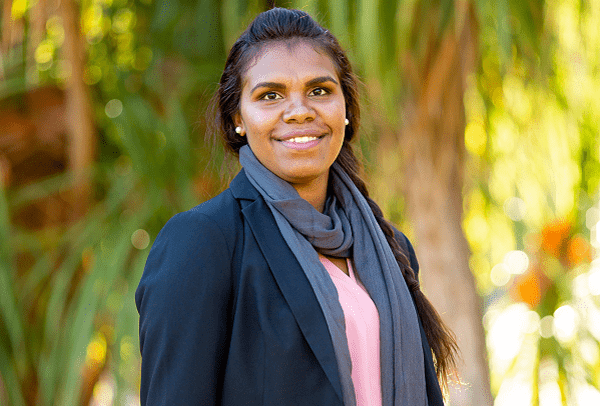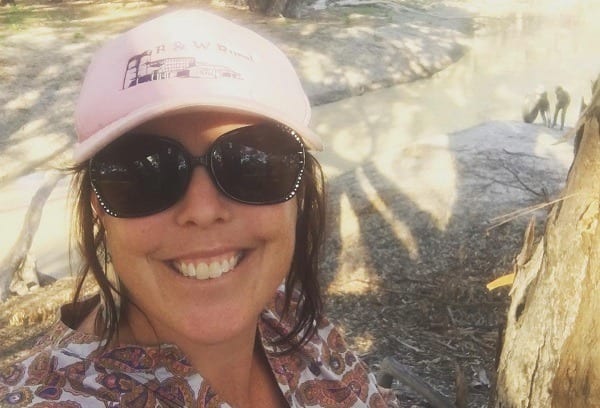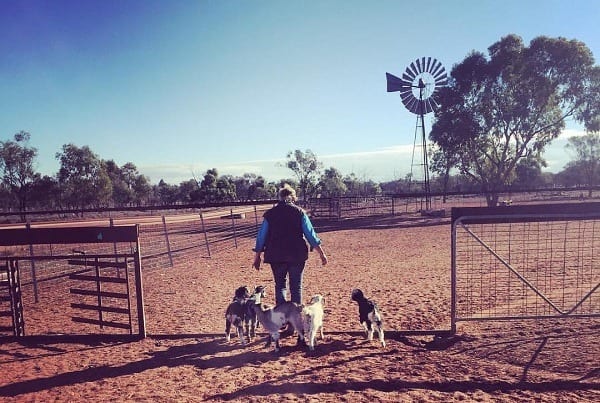The stereotypical male image of the Australian farmer could soon be replaced by that of a young, determined, educated woman, who is using innovation to boost profitability and diversity in agriculture.
Women comprise an estimated 32 per cent of workers in agriculture, according to Department of Agriculture ABARES figures. But that figure is likely to be higher, with many women not rightly recognised for their contribution to agriculture, leading industry body AgriFutures says.
________
Get The Ag Wrap! Our weekly newsletter for women in agriculture
A gender balance in agriculture is slowly forming, according to AgriFutures general manager of capacity building, Belinda Allitt, and women look set to play an even bigger role in the future.
Women currently comprise 55 per cent of all students studying agricultural science at university and they are leading the way when it comes to introducing new technology and innovation to the industry.
Careers in agriculture have moved beyond traditional farming to varied professions from engineering and programming to food innovation, science, entrepreneurialism and finance.
“It’s a huge change from as recently as 1994, when women weren’t permitted to list their legal status as a farmer. Instead, women on the land were officially defined as silent partners, ‘domestics’, ‘helpmates’, or even farmers’ wives,” says Belinda.
More opportunities for women
Many businesses in agriculture are thriving under female leadership. While sheep, beef, cattle and grain farming still account for more than half of the industry’s employment, other subsectors such as fruit and nut growing, dairy and bees and honey are expanding.
“The business model of farming is constantly evolving and this provides opportunities for women to think differently. Women bring resilience and adaptability in an evolving landscape,” Belinda says.
“Women see no boundaries in agriculture.”
More than 228,000 people work in agriculture and of those, 82% reside in regional or rural areas, ABARES figures show.
However, that number rises to almost half a million people when the wider workforce associated with agriculture is considered (such as manufacturing and wholesale trade). Agriculture is still very much a family-business dominated industry, with more than half of the country’s farmers and farm managers owning the enterprise and 26% of the remainder are family members.
It’s no surprise that women in agriculture are among the country’s hardest workers. Not only do they work exhaustingly long hours on properties, they do more domestic work than city women (75% do five or more hours of house work a week, 16% more than the national average) and more volunteer work (37% compared to 23%), according to ABARES. They also do more volunteer work than their city counterparts.
It is estimated women also earn a massive 75% of “off-farm” income – or wages sourced outside the traditional agricultural income streams. This income is often crucial in supporting farming families during tough economic periods.
Women changing the workforce
Darrylin Gordon, a Juru woman and pastoralist from Halls Creek WA, is an example of how a new generation of farmers are working hard to bring a new talent to agriculture and work to solve issues in the wider community at the same time.
Darrylin works on the Ngunjiwirri Aboriginal Corporation-owned Lamboo Station in the Kimberley, where she was born and raised. She runs three-month camps at the station to develop life-skills of indigenous participants and hopefully help them find work in agriculture, mining and tourism.

Last year Darrylin was named runner-up at the WA AgriFutures Rural Women’s Awards. She used two bursaries that she received, totaling $15,000, to develop her program, and in the last 12 months she has trained 15 local indigenous people.
Darrylin wants to break down cultural and social barriers, while upskilling young aboriginal people for the future. She wants to act as a circuit breaker between white people and indigenous people when it comes to work and training.
“Growing up in Halls Creek one of the key problems was employment and the lack of employment. The problem is the [lack of skills], we have got the right people, the right work ethic but it’s those physical skills, the ability to be able to go out and do these jobs.
“My work is about providing a space and a place for local people to come, learn and grow and it’s about where change begins. It’s improving and hopefully increasing aboriginal involvement in the economic world. How do I do that? I guess by starting locally.
By addressing issues with education and up-skilling of local people, Darrylin hopes she will make inroads with problems around unemployment and also boost the profitability of local businesses. So far, the program has been an astounding success and she has had positive feedback from both business owners and participants.
“Because of the opportunities we’re creating, the future is going to look deadly!” she says.
About 11% of agricultural workers are from culturally diverse backgrounds – a percentage that is growing year-on-year – and just 1% identify as indigenous, ABARES figures show. Of the small proportion of farmers who identify as indigenous, just 23% are female (down on 32% of non-indigenous workers). However, a large proportion (44%) of indigenous people who work in agriculture are young, aged between 15 and 34.

Education and tenacity is providing women like Coolah NSW farmer, Allison Mudford, with a plethora of opportunities in agriculture. A born high achiever, Allison works part time the Foundation for Rural & Regional Renewal working on projects with rural communities to build their capacity to manage burnout risks.
The mother of three also works on her family’s 2,500-acre farm (both physically on the farm as well as managing the accounting and marketing of the business). Allison sits on the board of the Hunter Land Services and the National Parks and Wildlife Services’ regional advisory panel, northern inland. In her “spare time” she teaches swimming at the local swimming club, is secretary of the local school P&F committee and works with the pony club and Coolah development committee.
“I believe women are the future in agriculture. While things are changing, they are still highly undervalued,” she says.
‘Hard word… But nothing else like it’
After being introduced to the diversity of a career in agriculture at school, Allison studied Agricultural science at Melbourne University and went on to be employed by Landcare, where she worked her way up the corporate level to managerial level. By the age of 21 she bought her own farm. It was a few years after that when she met her husband Daniel, who was working for the fire services and had his own farm. Together they purchased a farm in the Macedon Ranges, Victoria, and they continued to work in their corporate jobs while farming on the side. Six years ago they took the plunge into full time farming.
Scaling up their farming operations was always the goal, and five years ago they sold their Victorian farm and purchased a 2,5000 property in Coolah, NSW business was booming. But bushfires in 2017 destroyed about half of their 2,500-acre property and drought has been relentless, leading them to sell about half of their stock and cutting crop production for three years.
Allison’s “off-farm” job has helped to support her family along with the diversification of their farming assets (she still has land in Victoria that they run stock on). Technology has also helped to streamline business practices – allowing them to simply monitor everything from industry trends to their own stock and prices. The couple’s three children – aged 8 and under – are also a great help on the farm.
“It’s such hard work. The hours are relentless and it’s draining – but there’s nothing else like it. We love it and wouldn’t have it any other way,” she says.
“This is a great way to bring up our children.”

Recognition of women’s work has had a “180-degree change”
Women in Agriculture have come a long way in the past two decades, farmer and best-selling author, Fleur McDonald, says. She began working in farms in the 1990s at a time when women identifying as farmers or agricultural workers was not the “done thing”. She was often ridiculed for her choices, and experienced sexual harassment at the hands of an overseer. While this kind of behaviour still probably happens occasionally, Fleur – who is the Vice President and a board member of industry body, Women in Agriculture – says the recognition of women’s work in the industry has experienced a “complete 180-degree change” in the past 25 years.
“The young women coming into agriculture have so much self-confidence and self-belief…it is great to see,” Fleur says. “We have women networks now that are so supportive and encouraging and that really makes a difference.”
Life most women in agriculture – Fleur holds several paid and unpaid roles. In addition to owning land in WA, writing two novels a year and sitting on the board of Women in Agriculture, runs Breaking the Silence, a not-for-profit organisation for rural women and children escaping domestic violence.
When it comes to hardship, strong community networks of women and regular “girls talks” through rural women’s days are crucial in maintaining mental health and wellbeing.
“We work hard and we understand that we need to ‘saddle up and keep going’ when things get tough,” Fleur says.
The opportunities… and the challenges
Chris Ferguson, a goat grazer from outback NSW, is better known as the voice behind the popular social media blog, Life in the Mulga. The passionate advocate for rural Australia has more than 8,000 social media followers and uses her voice to express the challenges impacting life in regional Australia – namely the drought.
Chris, who has three large properties throughout rural NSW covering about 80,000 acres, has worked on farms since she was young, but it wasn’t until she was 30 and living in Bathurst with her then husband and two children that they decided to purchase land. “I hate that my kids were growing up in town,” she says. “So we bought a rundown station in outback NSW and began running goats.”
Years later after her marriage broke down, Chris bought out her ex-husband’s share in the property. She farmed as a single woman for several years before re-partnering another farmer, and together they combined their land value and purchased another large farm.
While education is encouraging more people into the agriculture industry, there is still a lack of people, businesses and services in rural areas. Without basic services, many rural areas will fail to prosper in the future, she says.
“We need more people in agriculture and more people in our rural towns,” she says. “Without people there is nothing.”
It isn’t all doom and gloom though – the drought has given many women an opportunity to have a greater role across the industry. Women-led initiatives, such as the social media campaign #buyfromthebush encourage and support women in rural areas to buy Christmas presents from small rural businesses affected by the drought. Chris says such initiatives are an excellent way of providing support to rural people and small agricultural businesses and connecting communities.
Drought, water security and connectivity are among the most pressing challenges currently affecting the Australian agriculture industry. Raising families in the bush and the burden of keeping rural, remote and regional communities thriving is also a huge issue for women working in agriculture
“There are opportunities and challenges in agriculture – but I think understanding them is important. Mainly we need to see more people living in rural and regional areas, and I hope it’s something I will see in my lifetime” Chris says.
“Women in agriculture are tough. That’s what I wanted to show through my photos on Instagram and Facebook – the real face of agriculture in Australia.”
Get The Ag Wrap! Our weekly newsletter for women in agriculture


